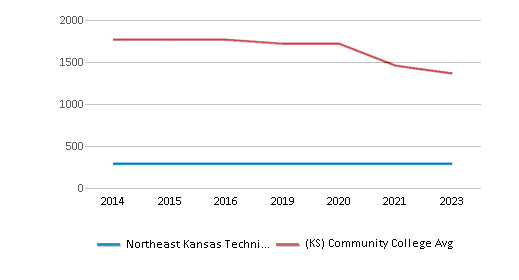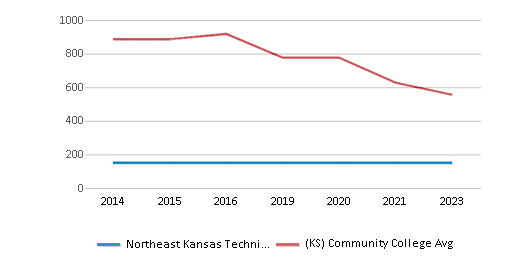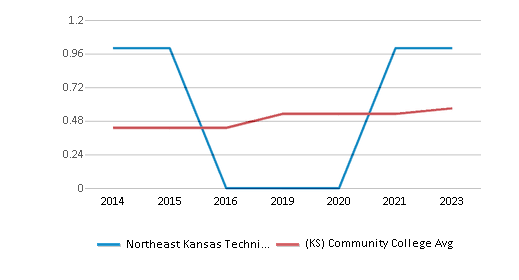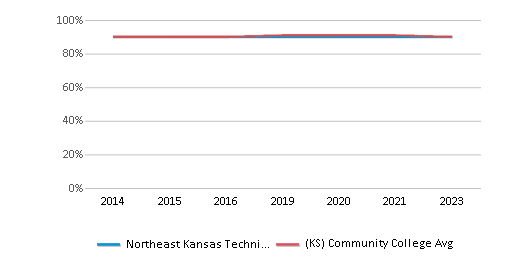- Highland Community College, the first college in Kansas, provides lifelong learning opportunities and contributes to economic development to enhance the quality of life in the communities we serve. The college also exists to serve each student. It provides educational leadership to help each individual become a well-informed, responsible citizen and a productive member of society. The most important people in ensuring the quality of your academic life at HCC are the faculty. Just as they are prepared to assist you in the classroom with quality instruction, they will also be involved with you outside the classroom as advisors, intramural opponents, and friends. Get to know them. They are looking forward to working with you to meet your educational goals. Highland Community College is accredited by the North Central Association of Colleges and Schools.
School Highlights
Northeast Kansas Technical Center serves 289 students
Minority enrollment is 100% of the student body (majority Black and Hispanic), which is less than the state average of 40%.
Quick Stats (2025)
- Enrollment: 289 students
- Source: Integrated Postsecondary Education Data System (IPEDS)
Top Rankings
Northeast Kansas Technical Center ranks among the top 20% of public schools in Kansas for:
Category
Attribute
School Overview
Northeast Kansas Technical Center
(KS) Community College Avg.
Carnegie Classification
Associates--Public Rural-serving Small
Associate's Colleges: Mixed Transfer/Career & Technical-High Nontraditional
Institution Level
At least 2 years but < 4 years
At least 2 but less than 4 years
Institution Control
Public
Public
Total Faculty
n/a
170 staff
School Calendar
Student Body
The student population of Northeast Kansas Technical Center has stayed relatively flat over five years.
The Northeast Kansas Technical Center diversity score of 1.00 is more than the state average of 0.60. The school's diversity has stayed relatively flat over five years.
Total Enrollment
289 students
1,908 students

Student : Teacher Ratio
n/a
16:1
# Full-Time Students
n/a
606 students
# Part-Time Students
n/a
1,451 students
# Enrollment Undergraduate
n/a
231 students
# Full-Time Undergraduate Students
150 students
606 students

# Full-Time Graduate Students
n/a
11 students
# Part-Time Undergraduate Students
139 students
1,424 students
# Part-Time Graduate Students
n/a
5 students
Total Dormitory Capacity
n/a
342 students
% American Indian/Alaskan
n/a
1%
% Asian
n/a
3%
% Hispanic
n/a
15%
% Black
n/a
8%
% White
n/a
60%
% Hawaiian
n/a
1%
% Two or more races
n/a
4%
% Non Resident races
n/a
2%
% Unknown races
100%
6%
Diversity Score
n/a
0.60

College Completion Rate (Students who graduate in less than 4 years)
n/a
0.4101%
College Completion Rate (Students who graduate in 4 years or more than 4 years)
n/a
0.3056%
Tuition and Acceptance Rate
% Students Receiving Some Financial Aid
90%
90%

Median Debt for Graduates
n/a
$8,892
Median Debt for Dropouts
n/a
$5,467
Acceptance Rate
n/a
100%
ACT Composite
n/a
21
Source: 2023 (or latest year available) Integrated Postsecondary Education Data System (IPEDS)
Frequently Asked Questions
What is Northeast Kansas Technical Center's ranking?
Northeast Kansas Technical Center ranks among the top 20% of community college in Kansas for: Average community college minority breakdown.
Recent Articles

Obtaining Your Bachelor's Degree at a Community College
Explore the evolving landscape of community colleges offering bachelor's degrees, addressing affordability, accessibility, and workforce needs.

A to Z of Community College Certificates and Courses
From business and healthcare to technology and skilled trades, the article showcases the breadth of options available to students seeking to enhance their knowledge, develop new skills, or pursue career advancement.

What is a Community College?
This comprehensive guide explains what a community college is, its history, and its role in higher education. It covers the types of programs offered, differences from four-year colleges, benefits of attending, and important considerations for prospective students, providing valuable insights for those exploring educational options.





